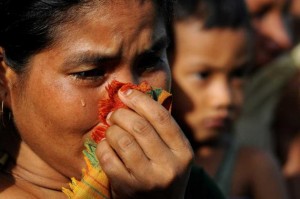Ernestina Coast, Tiziana Leone, and Alankar Malviya find that gender-based violence is consistently under-reported and point to flawed government policies that assume married women are safe from violence.
Gender-based violence (GBV) is a global public health concern that has only recently received significant research and policy attention. It is one of the most common forms of violence globally and includes physical, sexual, emotional, and economic violence. Studies from India suggest a relatively high prevalence of GBV and estimates vary widely, from 18 per cent to 70 per cent of women, reflecting in part a wide variety of methodologies to document such violence. Although the issue has been highlighted in India with the Protection of Women from Domestic Violence Act in 2005, GBV remains under-reported.
Data from the International Crime Victimisation survey, cited in the World Report on Violence and Health, reports that 1.9 per cent of women aged 16 and above in Mumbai report having been sexually assaulted in the last five years. In one six-state study, 40 per cent of women reported physical assault by a male partner. Recent estimates of lifetime partner violence among ever-married women are 39.7 per cent for all types of violence (emotional, physical or sexual). A study of 2,000 pregnant Indian women found that 30.7 per cent of women who had not wished to have sex had been forced to do so, while a separate survey of 397 women in rural South India reported that 34 per cent of women had been hit, forced to have sex by their husband, or both.
Gender-based violence is a product of social context and has been traditionally condoned and culturally sanctioned in India. This is reflected in women’s attitudes towards violence: analyses of National Family Health Survey data (2005) in rural South India show that 96 per cent of women believe that intimate partner violence (IPV) is acceptable in at least one circumstance. Given the social dimension of GBV and IPV, it is interesting to note that increased socio-economic status is associated with the lower likelihood of IPV in India, while lower dowry levels are associated with significantly higher subsequent risks of violence.
What are the health implications of widespread GBV? Evidence from India reflects global patterns, and shows implications for murder, attempted suicide, mental ill-health, poorer health outcomes for women and children, and HIV risk. Reproductive tract infections (RTIs) also account for a large burden of disease in low-income settings because of their role in making HIV transmission more effective and because of their impact on reproductive and child health.
Beyond health concerns, domestic violence has substantial social and economic costs that impact at the individual, household, community, and national levels. The financial costs of GBV range from direct costs (including health care, judicial, and social services) to indirect costs (including lost productivity from paid and unpaid work and foregone lifetime earnings from mortality due to GBV).
In this context, this study asks what levels of violence – both IPV and other forms of GBV – are reported by women and girls? Second, it asks how men and women perceive differences in sexual rights? And finally, what are the links between socio-demographic characteristics and health-related outcomes (RTIs) for women who report experiencing violence? The analysis is based on quantitative data collected in 2007 from five districts in India: Kanpur, Kishanganj, Bellary, Guntur, and Aizawl.
The authors asked all women, married and unmarried, whether they had ever been forced to have sexual intercourse or perform any other sexual acts against their will. For currently married women the reported perpetrators are overwhelmingly known to the respondents, including current/former husbands and boyfriends and other relatives. More than one quarter (26.7 per cent) of currently married women report forced sex in their current marriage. However, the responses from currently married women need to be interpreted with caution as 27.7 per cent of women refused to answer this question, suggesting that the statistics represent an under-reporting of the extent of forced sex within marriage. This suggestion is corroborated by married women’s responses to a hypothetical question about what would happen if they did refuse sex, with 36.7 per cent of women reporting that they would be forced to have sex.
Never-married respondents report higher levels of stranger as perpetrator in incidents of GBV. With regard to non-sexual violence experienced by women and girls, the level and type of reporting of abuse is remarkably similar between currently married and never-married women, reporting 21 per cent and 22 per cent, respectively. Both married and never-married women report older women – either mother-in-law or mother – as the second-most common category of abuse perpetrator.
Despite these findings, focus group discussions revealed perceptions that GBV was perceived to be a problem for specific population sub-groups, in particular those identified as Dalit. Moreover, the link between multiple behaviours – sexual violence and alcohol consumption – was attributed to Dalit communities. This is a clear example of the ‘othering’ of stigmatised and taboo behaviour by people in positions of relative power.
When the authors considered the patterns of forced sex reporting by socio-demographic characteristics, they found that more than three quarters (77 per cent) of women with more than eight years’ schooling report their partner has never had sex with them when they were unwilling, compared to just 45 per cent of women with no schooling. The study also shows a significant educational gradient for the reporting of RTI symptoms, reflecting a common pattern found elsewhere in India: the ability of women who have formal education to settle disputes in ways that do not involve physical violence and influence the unacceptability of violence in general. The authors do not suggest simplistically that female education has a strong protective effect on the risk of experiencing GBV. But they do point to evidence that shows that the influence of female education operates through changing community- and society-level factors that reduce the acceptability of violence.
Despite the widespread nature of GBV, few women sought any help for mistreatment. Among those who did seek help, married women most frequently reported approaching local government (Panchayat Raj), compared to never-married women, who were more likely to seek peer group support.
Even though married women who suffer GBV reach out to local government, marriage is perceived by policymakers and service providers (both health and police) as a setting in which women are safe and protected. Ever-increasing evidence suggests that this is far from the case. Indeed, for many women, marriage represents entry into setting where socially sanctioned violence against them can take place.
Substantial legislative changes have recently taken place in India, but the low levels of reporting and sentencing in GBV cases mean that these laws remain ‘paper tigers’. Without the adequate collection and reporting of data on gender-based violence – whether through crime rates or health system data – the continued under-reporting of GBV will reinforce the lack of attention that it is afforded. Unless gender-based violence is counted, it will continue not to count.
Ernestina Coast is a Senior Lecturer in Population Studies in LSE’s Department of Social Policy. Tiziana Leone is a Lecturer in Demography in LSE’s Department of Social Policy and a Senior Research Fellow, LSE Health. Alankar Malviya is the UNAIDS Adviser in Monitoring and Evaluation for Nepal and Bhutan, and has previously worked with the Government of Madhya Pradesh (India) and UNDP.
For more information on this study, including data, methodology, and citations to quoted statistics and related studies, see Coast, Leone, and Malviya’s chapter “Gender-based violence and reproductive health in five Indian states” in Gender-based Violence and Public Health: International Perspectives on Budgets and Policies, edited by Keerty Nakray (Routledge 2013).









1 Comments